Bachelor in History of Art and Archaeology: General
-
Schedule
regular course
- ECTS Credits 180
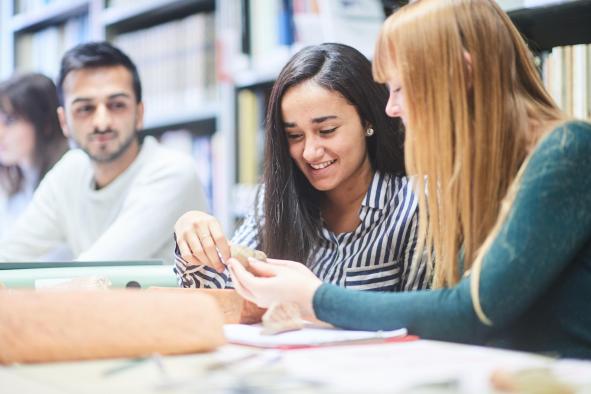
The program covers the major periods of history, from Prehistory to the Contemporary Era, and different geographical areas, from Western Europe to the Near East.
The first block of the bachelor's degree lays the fundamental foundations of art history and archaeology, studying the evolution of material culture, techniques, forms and styles. Training in the humanities (history, philosophy, culture, literature, ethnology...) ensures the development of a humanistic approach.
In the second block, you choose a major: Antiquity or the periods from the Middle Ages to the Contemporary Era. You study these periods in greater depth and learn to work independently, developing the tools and methods of art history and archaeology (museology, archaeometry, heritage conservation, archaeological site management). The learning of languages, ancient and modern depending on the course chosen, is part of this desire to understand the traces of the past.
You're off to a good start
- the traces of past civilizations and artistic heritage fascinate you;
- you memorize visual information easily;
- you enjoy working in the field or spending time in a museum;
- your desire for knowledge leads you to seek out and use various sources of information;
- you have a critical and analytical mind.
Teaching methods
Methodology, practical work, projects, seminars, excavation internships, study trips... every effort is made to ensure your scientific training and the application of the methods and techniques of art history and archaeology.
Field visits
A good education in archaeology and art history is nourished by direct contact with archaeological material and works of art. That's why you take part in study trips, on-site seminars, internships, visits to museums and exhibitions, monuments, archaeological sites... The department provides you with a personal tablet as well as the tools of archaeologists and art historians: drawing equipment, photographic equipment, 3D survey and topography equipment, microscope, etc.
Initiation to archaeological excavation
The annual field school is your first supervised experience of archaeological field research.
From handling tools to interpreting remains, you'll learn the practical, technical and scientific aspects of excavation.
Initiation to documentation techniques
Initiation to archaeological drawing, photography and 3D surveys prepares you to build up the documentation essential for the study of excavated material and artistic heritage. You'll also learn to manage databases, use photographic retouching and computer-aided drawing programs to digitize and process your graphic documentation or field surveys.
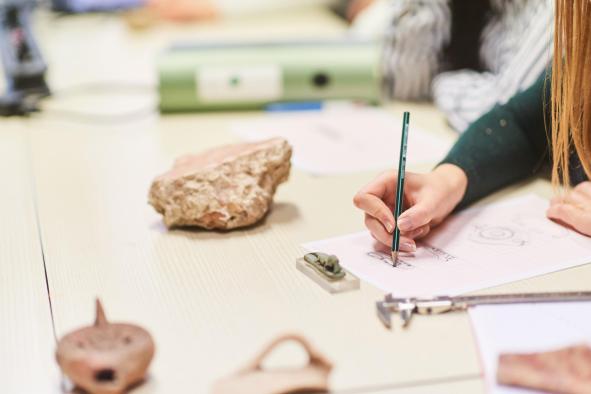
Methodological training for personal work
Whether you're out in the field, researching in the library or in the middle of writing your personal work, our teachers and assistants are there to support you. They monitor and evaluate your concrete steps, while taking into account your specific pace and learning style.
Manipulate and experiment to understand
The Department of Archaeology and Art Sciences puts at your disposal an Archaeology and Art Sciences Laboratory where a didactic collection of archaeological objects, works of art, tools and samples of materials traditionally used by Man (stone, earth, wood, metal, glass) is kept. To interpret the original traces you observe on objects, buildings or works of art, you handle these objects in technology classes and learn to handle certain tools in experimental workshops.
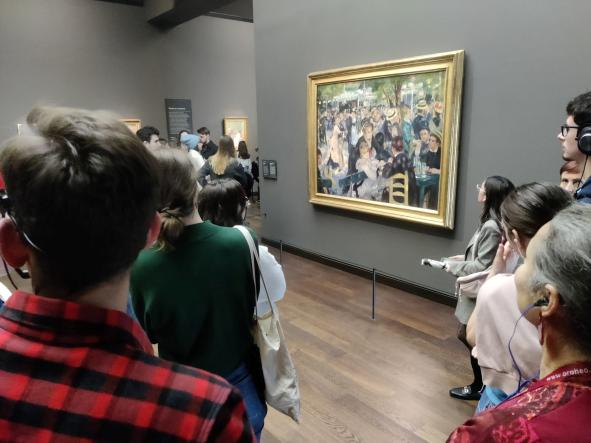
A week-long trip to the heart of your subject of study!
The study trip allows you to put your knowledge into perspective and integrate specific fieldwork methodologies.
In block 2: trip on the theme of ancient architecture
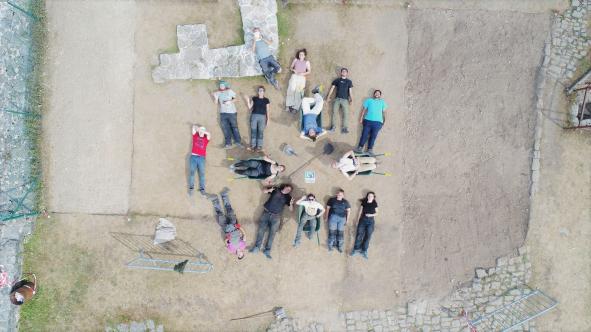
- Many months before departure, you choose and prepare your subject based on the available literature.
- On site, you discover the reality of the field and learn to guide your gaze to describe the chosen monument and try to understand its history, architectural styles and décor. You'll apply what you've learned from the theory lessons and the exercises you've already practiced in the field. Our teachers will ensure that you make the best possible progress in the face of any difficulties you may encounter. Visits to museums and other sites broaden your outlook.
In Block 3: the on-site seminar, a unique feature
- Your subject, which covers different periods of archaeology and art history, is chosen just a few weeks before departure.
- On site, you plan your work in complete autonomy, searching for traces of the past (with the naked eye and using instruments). You record your observations using a precise, structured method (field notebook, surveys, photographs, diagrams).
- The system includes continuous assessment. So you can make mistakes, but you can't go astray... because at the end of the week, the work to be handed in must be ready! You'll then be able to apply your knowledge and skills as you would in your future professional context.
Success aids
Succeeding in a year of study at university involves many challenges.
To help you meet them, UNamur supports you in developing your disciplinary, methodological and human skills... with the support of numerous professionals.
Preparatory courses, individualized help... Discover the schemes set up for your training.
After the baccalauréat: the master's degree
The Bachelor's degree in Art History and Archaeology opens the doors to all masters in Art History and Archaeology in Belgium or abroad.
Master's degrees allow you to move towards a specialized professional, in-depth (research) or teaching (master's in teaching) goal.
If you wish, you can complete your training at UNamur by enrolling for the bachelor's degree in History for which you will benefit from numerous exemptions (including all first-block courses, common to both the Art History and History programs) allowing you, by adding History courses to your second and third year Art History program, to earn this second degree in an additional academic year.
-
<unknown>
Code Name Staff Th.+Ex. Credits/Block 1 2 3 LARTB028 Archaeology and Art History. Contemporary period 30h th. LARTB012 Archaeology and Art History. Modern times 30h th. LARTB011 Archaeology and art history. Middle Ages 30h th. LARTB111 Archaeology and Art history : Greek and Roman Antiquity 30h th. LARTB110 Archeology and Art History. Antiquity - Ancien Near East-Egypt 30h th. LARTB109 Archaeology and Art History. Prehistory and Protohistory 30h th. LARTB214 Aesthetics and theories of art 30h th. LARTB022 National Archaeological Issues: Prehistory and Protohistory 30h th. LARTB030 National Archaeology Issues: Gallo-Roman and Early Medieval Periods 30h th. IMEPB100 History of music 30h th. -
<unknown>
Code Name Staff Th.+Ex. Credits/Block 1 2 3 LLETB101 Introduction to writing a scientific paper 15h th. LLETB102 Bibliographic methods: libraries and the internet 30h th. + 15h ex. LHISB001 Historical criticism 30h th. + 15h ex. LHISB102 Research approaches in history 15h th. LARTB101 Research approaches in art history and archaeology 15h th. LARTB215 Epistemology of Archaeology and Art History 15h th. LARTB207 Technology: architecture 22.5h th. + 7.5h ex. LARTB208 Technology: archaeological furniture and visual arts 22.5h th. + 7.5h ex. LARTB210 Iconology 30h th. LARTB213 Excavation methods and archaeological site management 15h th. LARTB211 Technical documentation (computerised files, surveys, drawings, photographs, etc.) 30h th. LARTB301 Introduction to Archaeometry 15h th. LARTB302 Museology 30h th. LARTB303 Conservation and study of heritage 30h th. LARTB304 Building archaeology 15h th. LARTB313 Introduction to practice: on-site seminar 7.5h th. LARTB314 Excavation methods and archaeological site management: excavation course 7.5h ex. -
<unknown>
Code Name Staff Th.+Ex. Credits/Block 1 2 3 LARTB306 Museology observation course 7.5h ex. LARTB315 Observation course in conservation and heritage studies 7.5h ex. LARTB316 Archaeological observation course 7.5h ex.
-
-
<unknown>
Code Name Staff Th.+Ex. Credits/Block 1 2 3 LCLAB101 History of Antiquity 45h th. LHISB004 History of the Middle Ages 30h th. LHISB003 History of Modern Times 30h th. LHISB002 History of the Contemporary Era 30h th. LCLAB212 Heuristics of Antiquity 30h th. LHISB210 Heuristics of the Middle Ages 30h th. + 15h ex. LHISB211 Modern Day Heuristics 30h th. + 15h ex. LHISB212 Heuristics of the Contemporary Era 30h th. + 15h ex. -
<unknown>
Code Name Staff Th.+Ex. Credits/Block 1 2 3 LLETB103 Introduction to Western literature 30h th. -
<unknown>
Code Name Staff Th.+Ex. Credits/Block 1 2 3 LHISB101 Religious Studies 30h th. LPHIB105 General introduction to philosophy 45h th. LLETB001 Books and digital culture 30h th. LLETB002 History of ancient literature and its legacies 30h th. LPHIB010 Introduction to the Humanities 30h th. LPHIB212 Ethnology 30h th. -
<unknown>
Code Name Staff Th.+Ex. Credits/Block 1 2 3 LELVB001 English 2 (level B1 or higher) 60h th. LCLAB012_P35792 <unknown> 30h th. LCLAB011_P35790 <unknown> 30h th. LCLAB003_P35788 <unknown> 30h th. LCLAB009 Introduction to the Latin language 45h th. + 15h ex. LCLAB007 Reading of Latin texts 45h th. LANGB002 Introduction to the English language (level A2) 30h th. + 30h ex. LNRLB207 Introduction to the Dutch language (level B1) 30h th. + 30h ex. LANGB003 English literary history I (600-1660) 30h th. LELVB301 English 3 (level B2 or higher) 60h th. LCLAB006_P35780 <unknown> 30h th. LCLAB013_P35782 Explanation of Greek authors B 30h th. LCLAB014_P35784 <unknown> 30h th. LARTB048 Introduction to Ancient Egyptian 30h th. LALLB001 Reading of German texts I 30h th. LCLAB004 Introduction to the Greek language 45h th. + 15h ex. LCLAB005 Reading of Greek texts 45h th. LALLB002 Reading German texts II 30h th. LANGB004_P35868 English literary history II (1660-present) 45h th. LROMB103 Italian I 15h th. + 60h ex. -
<unknown>
-
<unknown>
-
<unknown>
Code Name Staff Th.+Ex. Credits/Block 1 2 3 LARTB025 Medieval painting and sculpture 30h th. LARTB027 Contemporary Era I 30h th. LARTB043 Architecture and monumental decor of the Modern Age 30h th. LARTB040 Architecture and monumental decoration of the Middle Ages 30h th. LARTB026 Painting and sculpture in the Modern Age 30h th. LARTB047 Contemporary Era II 30h th. -
<unknown>
Code Name Staff Th.+Ex. Credits/Block 1 2 3 LARTB202 Heuristics, methodology and personal work and study trip. Middle Ages / Modern times 30h th. + 30h ex. -
<unknown>
Code Name Staff Th.+Ex. Credits/Block 1 2 3 LARTB310 Methodology. Middle Ages and Modern Times 15h th. + 30h ex. LARTB312 Methodology. Contemporary period 15h th. + 30h ex. LARTB318 End of cycle work. Middle Ages and Modern Times. Objects 15h th. + 30h ex.
-
-
<unknown>
-
<unknown>
Code Name Staff Th.+Ex. Credits/Block 1 2 3 LARTB023 Ancient Near East 30h th. LARTB009 Italic and Etruscan Antiquity 30h th. LARTB024 Pre-Hellenic and Greek Antiquity I 30h th. LARTB038 Roman antiquity 30h th. LARTB035 Pre-Hellenic and Greek Antiquity II 30h th. LARTB032 Egypt 30h th. -
<unknown>
Code Name Staff Th.+Ex. Credits/Block 1 2 3 LARTB203 Heuristics, methodology and personal work and study trip. Greek, Etruscan and Roman Antiquity 30h th. + 30h ex. -
<unknown>
Code Name Staff Th.+Ex. Credits/Block 1 2 3 LARTB307 Methodology and auxiliary sciences. Ancien Near East and Egypt 15h th. + 30h ex. LARTB308 Methodology. Greek, Etruscan and Roman Antiquity 15h th. + 30h ex.
-
-
-
<unknown>
Code Name Staff Credits Hours/Quarter 1 2 LARTB028 Archaeology and Art History. Contemporary period 3 30h th. LARTB012 Archaeology and Art History. Modern times 3 30h th. LARTB011 Archaeology and art history. Middle Ages 3 30h th. LARTB111 Archaeology and Art history : Greek and Roman Antiquity 3 30h th. LARTB110 Archeology and Art History. Antiquity - Ancien Near East-Egypt 3 30h th. LARTB109 Archaeology and Art History. Prehistory and Protohistory 3 30h th. -
<unknown>
Code Name Staff Credits Hours/Quarter 1 2 LLETB101 Introduction to writing a scientific paper 3 7.5h th. 7.5h th. LLETB102 Bibliographic methods: libraries and the internet 5 30h th. + 15h ex. LHISB001 Historical criticism 4 30h th. + 15h ex. LHISB102 Research approaches in history 5 15h th. LARTB101 Research approaches in art history and archaeology 5 15h th. -
<unknown>
Code Name Staff Credits Hours/Quarter 1 2 LCLAB101 History of Antiquity 3 45h th. LHISB004 History of the Middle Ages 3 30h th. LHISB003 History of Modern Times 3 30h th. LHISB002 History of the Contemporary Era 3 30h th. -
<unknown>
Code Name Staff Credits Hours/Quarter 1 2 LLETB103 Introduction to Western literature 3 30h th. -
<unknown>
Code Name Staff Credits Hours/Quarter 1 2 LHISB101 Religious Studies 3 30h th. LPHIB105 General introduction to philosophy 5 22.5h th. 22.5h th. -
<unknown>
Code Name Staff Credits Hours/Quarter 1 2 LELVB001 English 2 (level B1 or higher) 4 30h th. 30h th. LCLAB012_P35792 <unknown> 3 30h th. LCLAB011_P35790 <unknown> 3 30h th. LCLAB003_P35788 <unknown> 3 30h th. LCLAB009 Introduction to the Latin language 3 22.5h th. + 7.5h ex. 22.5h th. + 7.5h ex. LCLAB007 Reading of Latin texts 3 30h th. 15h th. LANGB002 Introduction to the English language (level A2) 3 30h ex. 30h th. LNRLB207 Introduction to the Dutch language (level B1) 3 30h ex. 30h th.
-
<unknown>
Code Name Staff Credits Hours/Quarter 1 2 LARTB214 Aesthetics and theories of art 3 15h th. 15h th. LARTB022 National Archaeological Issues: Prehistory and Protohistory 3 30h th. LARTB030 National Archaeology Issues: Gallo-Roman and Early Medieval Periods 3 30h th. LARTB109 Archaeology and Art History. Prehistory and Protohistory 3 30h th. LARTB110 Archeology and Art History. Antiquity - Ancien Near East-Egypt 3 30h th. LARTB111 Archaeology and Art history : Greek and Roman Antiquity 3 30h th. LARTB011 Archaeology and art history. Middle Ages 3 30h th. LARTB012 Archaeology and Art History. Modern times 3 30h th. LARTB028 Archaeology and Art History. Contemporary period 3 30h th. -
<unknown>
Code Name Staff Credits Hours/Quarter 1 2 LARTB215 Epistemology of Archaeology and Art History 2 15h th. LARTB207 Technology: architecture 2 22.5h th. + 7.5h ex. LARTB208 Technology: archaeological furniture and visual arts 2 22.5h th. + 7.5h ex. LARTB210 Iconology 3 15h th. 15h th. LARTB213 Excavation methods and archaeological site management 3 15h th. LARTB211 Technical documentation (computerised files, surveys, drawings, photographs, etc.) 3 15h th. 15h th. -
<unknown>
Code Name Staff Credits Hours/Quarter 1 2 LCLAB212 Heuristics of Antiquity 3 30h th. LHISB210 Heuristics of the Middle Ages 3 15h th. 15h th. + 15h ex. LHISB211 Modern Day Heuristics 3 15h th. 15h th. + 15h ex. LHISB212 Heuristics of the Contemporary Era 3 30h th. 15h ex. -
<unknown>
Code Name Staff Credits Hours/Quarter 1 2 LLETB001 Books and digital culture 3 30h th. LLETB002 History of ancient literature and its legacies 3 30h th. LPHIB010 Introduction to the Humanities 3 30h th. -
<unknown>
Code Name Staff Credits Hours/Quarter 1 2 LANGB003 English literary history I (600-1660) 3 30h th. LELVB001 English 2 (level B1 or higher) 4 30h th. 30h th. LELVB301 English 3 (level B2 or higher) 4 30h th. 30h th. LCLAB006_P35780 <unknown> 3 30h th. LCLAB013_P35782 Explanation of Greek authors B 3 30h th. LCLAB014_P35784 <unknown> 3 30h th. LARTB048 Introduction to Ancient Egyptian 3 30h th. LCLAB012_P35792 <unknown> 3 30h th. LCLAB011_P35790 <unknown> 3 30h th. LCLAB003_P35788 <unknown> 3 30h th. LALLB001 Reading of German texts I 3 30h th. LCLAB007 Reading of Latin texts 3 30h th. 15h th. LCLAB004 Introduction to the Greek language 3 22.5h th. + 7.5h ex. 22.5h th. + 7.5h ex. LCLAB005 Reading of Greek texts 3 22.5h th. 22.5h th. -
<unknown>
-
<unknown>
-
<unknown>
Code Name Staff Credits Hours/Quarter 1 2 LARTB025 Medieval painting and sculpture 3 30h th. LARTB027 Contemporary Era I 3 30h th. LARTB043 Architecture and monumental decor of the Modern Age 3 30h th. LARTB040 Architecture and monumental decoration of the Middle Ages 3 30h th. LARTB026 Painting and sculpture in the Modern Age 3 30h th. LARTB047 Contemporary Era II 3 30h th. -
<unknown>
Code Name Staff Credits Hours/Quarter 1 2 LARTB202 Heuristics, methodology and personal work and study trip. Middle Ages / Modern times 12 15h th. + 15h ex. 15h th. + 15h ex.
-
-
<unknown>
-
<unknown>
Code Name Staff Credits Hours/Quarter 1 2 LARTB023 Ancient Near East 3 30h th. LARTB009 Italic and Etruscan Antiquity 3 30h th. LARTB024 Pre-Hellenic and Greek Antiquity I 3 30h th. LARTB038 Roman antiquity 3 30h th. LARTB035 Pre-Hellenic and Greek Antiquity II 3 30h th. LARTB032 Egypt 3 30h th. -
<unknown>
Code Name Staff Credits Hours/Quarter 1 2 LARTB203 Heuristics, methodology and personal work and study trip. Greek, Etruscan and Roman Antiquity 12 15h th. + 15h ex. 15h th. + 15h ex.
-
-
-
<unknown>
Code Name Staff Credits Hours/Quarter 1 2 LARTB022 National Archaeological Issues: Prehistory and Protohistory 3 30h th. IMEPB100 History of music 3 30h th. LARTB030 National Archaeology Issues: Gallo-Roman and Early Medieval Periods 3 30h th. -
<unknown>
Code Name Staff Credits Hours/Quarter 1 2 LARTB301 Introduction to Archaeometry 2 15h th. LARTB302 Museology 3 15h th. 15h th. LARTB303 Conservation and study of heritage 3 30h th. LARTB304 Building archaeology 2 15h th. LARTB313 Introduction to practice: on-site seminar 6 7.5h th. LARTB314 Excavation methods and archaeological site management: excavation course 3 7.5h ex. -
<unknown>
Code Name Staff Credits Hours/Quarter 1 2 LARTB306 Museology observation course 2 7.5h ex. LARTB315 Observation course in conservation and heritage studies 2 7.5h ex. LARTB316 Archaeological observation course 2 7.5h ex.
-
-
<unknown>
Code Name Staff Credits Hours/Quarter 1 2 LPHIB212 Ethnology 3 30h th. -
<unknown>
Code Name Staff Credits Hours/Quarter 1 2 LCLAB007 Reading of Latin texts 3 30h th. 15h th. LANGB003 English literary history I (600-1660) 3 30h th. LELVB001 English 2 (level B1 or higher) 4 30h th. 30h th. LELVB301 English 3 (level B2 or higher) 4 30h th. 30h th. LCLAB006_P35780 <unknown> 3 30h th. LCLAB013_P35782 Explanation of Greek authors B 3 30h th. LCLAB014_P35784 <unknown> 3 30h th. LARTB048 Introduction to Ancient Egyptian 3 30h th. LCLAB012_P35792 <unknown> 3 30h th. LCLAB011_P35790 <unknown> 3 30h th. LCLAB003_P35788 <unknown> 3 30h th. LCLAB005 Reading of Greek texts 3 22.5h th. 22.5h th. LALLB002 Reading German texts II 3 30h th. LANGB004_P35868 English literary history II (1660-present) 3 45h th. LROMB103 Italian I 3 7h th. + 30h ex. 8h th. + 30h ex. -
<unknown>
-
<unknown>
-
<unknown>
Code Name Staff Credits Hours/Quarter 1 2 LARTB025 Medieval painting and sculpture 3 30h th. LARTB043 Architecture and monumental decor of the Modern Age 3 30h th. LARTB027 Contemporary Era I 3 30h th. LARTB040 Architecture and monumental decoration of the Middle Ages 3 30h th. LARTB026 Painting and sculpture in the Modern Age 3 30h th. LARTB047 Contemporary Era II 3 30h th. -
<unknown>
Code Name Staff Credits Hours/Quarter 1 2 LARTB310 Methodology. Middle Ages and Modern Times 12 7.5h th. + 15h ex. 7.5h th. + 15h ex. LARTB312 Methodology. Contemporary period 12 7.5h th. + 15h ex. 7.5h th. + 15h ex. LARTB318 End of cycle work. Middle Ages and Modern Times. Objects 12 7.5h th. + 15h ex. 7.5h th. + 15h ex.
-
-
<unknown>
-
<unknown>
Code Name Staff Credits Hours/Quarter 1 2 LARTB009 Italic and Etruscan Antiquity 3 30h th. LARTB023 Ancient Near East 3 30h th. LARTB024 Pre-Hellenic and Greek Antiquity I 3 30h th. LARTB032 Egypt 3 30h th. LARTB035 Pre-Hellenic and Greek Antiquity II 3 30h th. LARTB038 Roman antiquity 3 30h th. -
<unknown>
Code Name Staff Credits Hours/Quarter 1 2 LARTB307 Methodology and auxiliary sciences. Ancien Near East and Egypt 12 7.5h th. + 15h ex. 7.5h th. + 15h ex. LARTB308 Methodology. Greek, Etruscan and Roman Antiquity 12 7.5h th. + 15h ex. 7.5h th. + 15h ex.
-
-
Les métiers des historiens de l'art et des archéologues
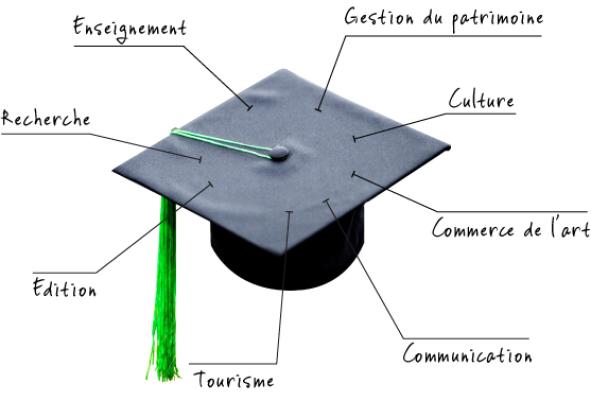
Professions of art historians and archaeologists
The Master's degree in Art History and Archaeology opens the door to a variety of jobs.
Heritage management
- Museums: management of collections, exhibitions, publications, research
- Heritage administrations: management, documentation and restoration of heritage
- Expertise : production of files prior to classification, restoration
- Excavations and management of sites and archaeological furniture
- Valorization of cultural heritage
Cultural events
- Houses of culture
- Exhibitions
- Conferences
The world of communication
- Journalism: art criticism, radio, television
- Cultural reporting
- Scientific consultancy
- Cultural attaché (embassies)
- Cultural services (private)
- Multimedia
Tourism
- Publications
- Excursions and guided tours
- Cultural tours (tour guide)
Art trade
- Antiquing
- Expertise
Publishing
- Art book design and production
- Bookshop
- Library
Teaching
- Higher education (4th-5th-6th humanities)
- Academies of fine arts, music, etc.
- Secondary and higher art schools
- Schools of tourism
Research
- Study of archaeological and artistic heritage
- Teaching and research at the University or Fonds National de la Recherche Scientifique (or equivalent abroad). A doctorate in Philosophy and Letters is required for access to the position of professor at the University.
Other career opportunities
The degree in Philosophy and Letters (History of Art and Archaeology) gives access to numerous career opportunities for which a university degree is required: civil service, communications, banking, insurance, NGOs, the associative world.